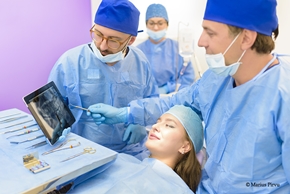Implantology
 Modern implantology
Modern implantology is a surgical-prosthetic technique for replacing one or more dental elements or completely rehabilitate a dental arch using one or more implants inserted into the bone. Implants are placed into the bone through a process called osseointegration.
These “screws” replace the natural root of the tooth with an artificial root (implant), where the prosthetic abutment is anchored or screwed into.
Implantology needs a thick residual bone that in many cases happens to be insufficient. Bone thickness can be increased through various surgical techniques, such as bone grafts taken from another place or made from suitable materials. Using implants to replace missing teeth is a standard and safe method that allows avoiding any damage to healthy teeth and has a good cost-benefit ratio compared to traditional prosthetic methods.
What are they and what are they used for?
Dental implants are titanium screws (the most biocompatible element with our body used, among others, for hip prostheses) inserted into the patient's bone tissue to replace the roots of the teeth that have been extracted for various reasons. Implants support various types of prostheses, from single-crown fixed ones to a dental bridge.
Who can benefit from a dental implant?
Insertion of dental implants is possible for most of the population. However, there are situations where they are not compatible or not recommended: decompensated diabetes; serious heart problems; serious osteoporosis; hard-core smokers (more than 20 cigarettes a day). Implants are inserted through a surgery that may or may not include an incision into the gum. Postoperative discomfort is comparable to tooth extraction and is reduced by the use of anti-inflammatory medicine.
How long does it last?
The duration of the dental implants depends on different factors, the most important of which are: patient hygiene, regular control visits and patient habits (smoking, sleep bruxism. etc.). International studies have proven a 90% success rate 10 years after the implant.
What if there is no bone?
Bones inside the oral cavity reabsorb and contract spontaneously after extracting a tooth or root, up to 50% after one year. In addition, the use of a movable denture helps speed up resorption. All this can lead to difficulties in positioning implants due to the lack of a foundation in which they would be inserted. However, nowadays, thanks to modern techniques such as “Guided Bone Regeneration” (GBR), we can solve very compromised situations in most cases.
After how long can implants be used?
The timeframe necessary from implant placement to their actual use depends largely on the type of use intended and the patient's amount of bone that determines the level of implant stability.
If conditions are favourable, implants can be used immediately after their placement to restore one tooth up to the entire dental arch.
What are Post-Extraction Implants?
It is an implant-laying method that provides, where possible and if allowed by the amount of bone remained, implant placement immediately after dental extraction, thus leading to a reduction in treatment period and surgical sessions.
What are Immediate Loading Implants?
This is an implant-laying method that allows positioning of a prosthesis (one crown, bridge or entire dental arch) within 24-48 hours of surgery with lessening of periods of discomfort caused by prolonged teeth missing. The possibility to benefit from this method is assessed by the specialist in implantology, based on careful preoperative (panoramic, TAC) and intraoperative (quality of available bone, implant stability) radiographies.
What are “All-on-4”, “All-on-6” Dental Implants?
These are two implant techniques created by Dr. Paulo Malo, which, by using 4 to 6 implants, provide complete rehabilitation of a full dental arch with a fixed prosthesis approximately 24-48 hours after implant placement.
What are the advantages of this technique?
One surgical and anesthesiological session
Minor discomfort and postoperative pain
A small number of required implants
Patient does not require a mobile prosthesis during the treatment
Solving the edentation issue in only one day
Possibility to eat and chew the same day of the intervention
POSTOPERATIVE ADVICE
1. Keep the gauze pad pressed between the arches for about 20-30 minutes.
2. Do not drive after surgery.
3. Bleeding, moderate pain, ecchymosis (manifested by the appearance of a reddish-violet spot near the surgical site) and swelling are frequent, and sometimes even a reduction in jaw opening may occur. These symptoms tend to increase until day 2-3 postoperatively, and then they gradually decrease. If further complications appear or if these symptoms get worse, contact your doctor.
4. To reduce swelling and pain, in the first 8-12 hours, apply a cold compress to the face in the affected area for 20 minutes with a 20-minute break.
5. Avoid intense physical exercise, rest for the day and keep your head up for the first 24 hours (the first night you would better sleep with two pillows under your head).
6. Do not smoke or drink alcoholic beverages for the first 3-4 days.
7. Do not chew gum.
8. Swallow saliva without spitting and do not rinse your mouth with water for the first 10 hours.
9. Consume semi-liquid and cold food for the first 24 hours. Until the suture thread is removed, mushy and warm food is recommended, chewing it on the opposite side. Do not drink using a straw.
10. Brush your teeth with a soft toothbrush only after the first 10-12 hours. Avoid traumatizing the operating area that needs to be cleaned only with a mouth rinse (2% chlorhexidine) for about 2 minutes, half an hour after brushing your teeth; if necessary, use the prescribed gel cream.
11. Do not take medications containing acetylsalicylic acid (aspirin) in order not to slow down and prevent coagulation.
12. Take the prescribed medication, as recommended.